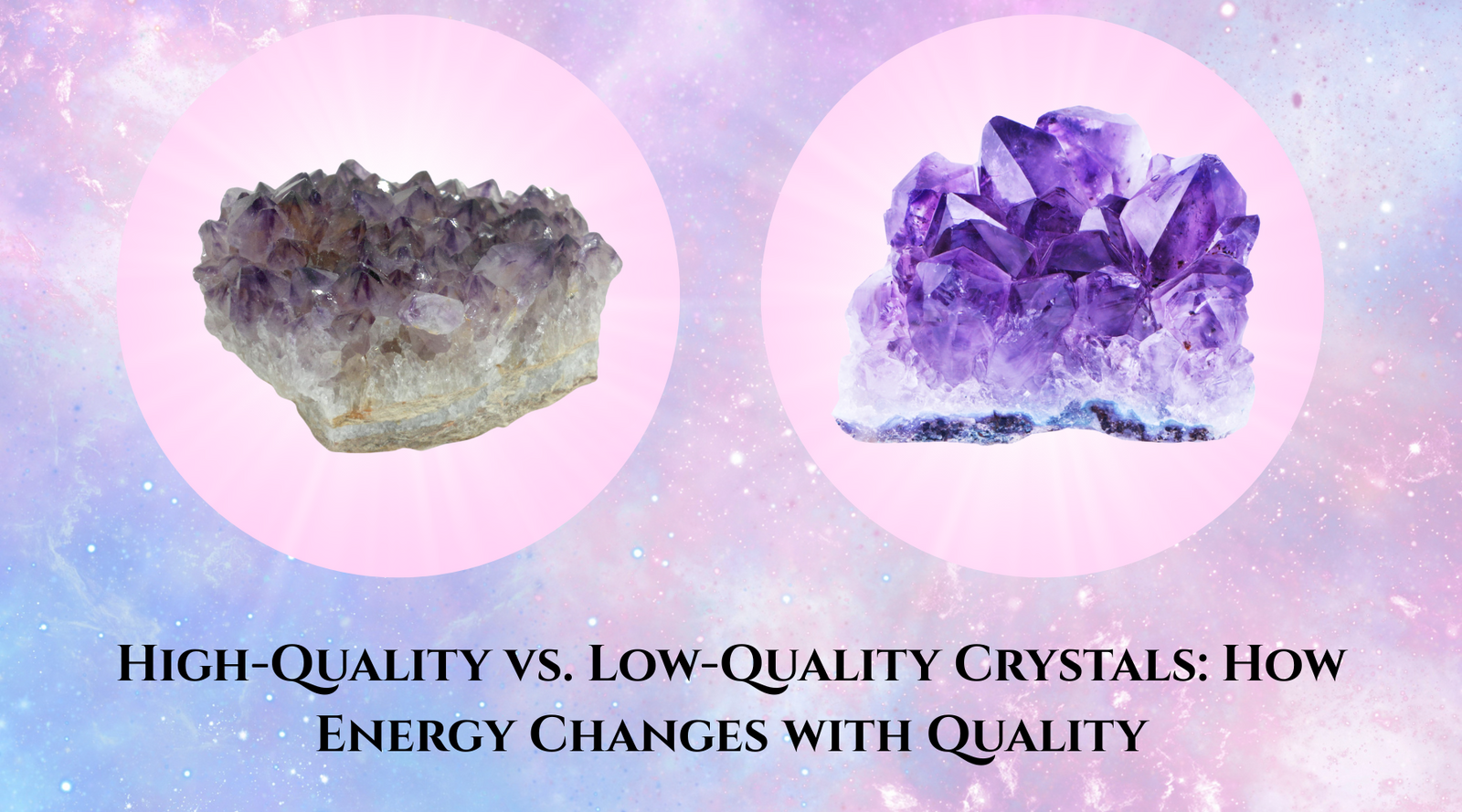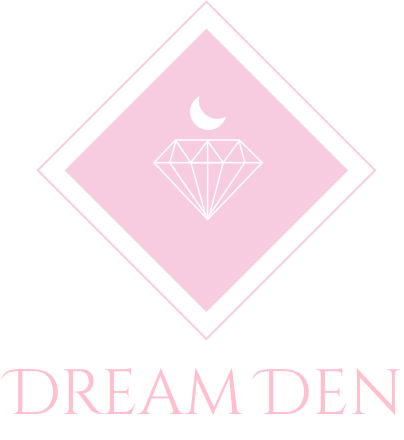
Not all crystals are created equal. Two stones can look similar on the shelf but feel wildly different in your hand. This guide explains how to spot quality, what affects a crystal’s energy, and why choosing better pieces can supercharge your practice-especially if you’re new to crystal healing.
Walk into any crystal shop and you’ll find two lookalikes: one sparkles with presence; the other… just sits there. Same mineral, different experience. The difference comes down to crystal quality - clarity, color, formation, finish, and even sourcing. In this beginner-friendly crystal quality guide, we’ll break down high-quality vs. low-quality crystals, how their crystal energy shifts with quality, and how to shop like a pro (without needing a geology degree).
What Determines Crystal Quality?
Quality isn’t just about “pretty.” It’s the combo of structure + authenticity that shapes how a stone carries and transmits energy.
- Clarity: In quartz and other translucent stones, clearer pieces tend to channel energy more cleanly. Heavy fractures can scatter or dampen flow.
- Color: Natural saturation (not neon or blotchy). Vibrant but believable. Dyed stones often feel energetically “off.”
- Cut & Polish: Well-cut points direct energy; smooth, even polish supports flow. Ragged tips or rough grinder marks can diffuse it.
- Form & Termination: Natural terminations, symmetry, and intact faces usually indicate stronger, more coherent fields.
- Inclusions: Natural inclusions can add character (hello, rainbow flashes). But excessive fractures may feel noisy.
- Ethical Sourcing: Respectful mining and fair trade matter-stones tend to feel “lighter” and you sleep better at night.
Note: Some minerals are supposed to be opaque or included (e.g., black tourmaline, lepidolite). “Quality” always respects the mineral’s natural look.
High-Quality Crystals
Appearance
- Natural, vibrant color (amethyst that glows; rose quartz with soft, even pink).
- Good symmetry; crisp point terminations; consistent polish with no flat spots.
- Quartz that looks water-clear or with minimal, attractive inclusions.
Energy
- Feels strong, clean, and focused when held.
- Responds quickly in meditation-easier to “drop in.”
- Amplifies intentions without static or heaviness.
Best Uses
- Daily healing rituals and energy work.
- Manifestation and affirmation practices.
- Jewelry you wear often, altars, or a home’s central grid.
Low-Quality Crystals
Appearance
- Dull or muddy color; suspiciously neon hues (often dyed).
- Chipped, heavily fractured, or poorly polished surfaces.
- Obvious man-made imitations (glass/resin “crystals”).
Energy
- Feels flat, scattered, or oddly heavy.
- Hard to connect with; meditation feels “noisy.”
- Inconsistent results-some days OK, others meh.
Risks
- Fakes: Glass/resin, reconstituted “franken-stones,” or mislabeled minerals.
- Harsh treatments: Dyed, heat-treated, coated stones that dampen natural vibration.
- Questionable sourcing: Ethical concerns and heavier energetic residue.
How Energy Changes with Quality
Picture two clear quartz points. One is cracked and cloudy; the other is bright and sharply terminated. In practice, the first may feel like static-your mind wanders, your intention drifts. The second? Your breath deepens, focus sharpens, and your intention clicks into place. That’s quality, felt as energy.
- Hold a piece you suspect is lower quality. Breathe for 60 seconds. Notice sensations, emotions, and thoughts.
- Switch to your best piece of the same mineral. Repeat.
- Compare: clarity, calm, body sensations, and how easily intention “locks in.”
- Higher-quality = cleaner channel: Less noise, more focus.
- Amplification: Quality pieces boost intentions and pair beautifully with other stones.
- Beginner-friendly: The difference is easier to feel, which builds confidence and consistency.
How to Tell If a Crystal Is High-Quality (Shopping Tips)
Quick Checklist
- Natural color: Rich but realistic (avoid neon/ink-looking dye pools).
- Formation: Points with intact tips; clusters with defined crystals.
- Finish: Even polish, no gummy residue, no obvious grinder burns.
- Feel: Trust your body. Tingles, warmth, calm focus = green flags.
- Seller transparency: Clear labeling and willingness to answer questions.
Red Flags (Real vs. Fake Crystals)
- Too perfect, too cheap: Rare minerals at bargain-bin prices? Hmm.
- Glass vibes: Bubbles inside, mold lines, or plasticky shine.
- Coatings/dyes: Aura coatings, neon agates, wildly uniform “citrine” (often heat-treated amethyst).
- Mislabeled species: Do a quick search on common fakes before big purchases.
Prefer to skip guesswork? Shop pre-vetted pieces in our High-Quality Crystals for Healing collection.
When Low-Quality Is Still Okay
Hot take: you don’t need museum-grade everything. Lower-grade pieces can still serve a purpose.
- Budget beginnings: Start small, learn your preferences, upgrade later.
- Crystal grids: Many small pieces together = strong collective field.
- Decor/vibe-setting: Use display clusters where symbolism matters more than precision.
Think of low-grade pieces as the chorus and high-grade pieces as the lead singer. Both have a role; they just shine differently.
High-Quality vs. Low-Quality Crystals — At a Glance
| Feature | High-Quality Crystals | Low-Quality Crystals |
|---|---|---|
| Appearance | Vibrant, natural color; clean structure; crisp terminations | Dull/neon dyed; chipped; heavily fractured or uneven polish |
| Energy | Strong, pure, focused; quick to connect | Weak, scattered, inconsistent; “flat” feeling |
| Best Uses | Healing, manifestation, meditation, jewelry | Decor, grids, experimentation, budget starts |
| Risks | Minimal when genuine & ethically sourced | Fakes, harsh treatments, murky sourcing |
Quick FAQ
Do I need high-quality crystals for everything?
No. Use premium pieces for healing, meditation, or core intentions. Use lower-grade pieces for décor or grid “backup singers.”
Are treated stones always bad?
Not always—but heavy dyes, coatings, or extreme heat can mask or muddle a stone’s natural vibe. When in doubt, go natural.
How can I start upgrading on a budget?
Pick one premium “anchor” per intention (e.g., a great amethyst or quartz point), then build around it with affordable tumbles.
Wellness note: crystals complement—not replace—professional medical or mental-health care.

